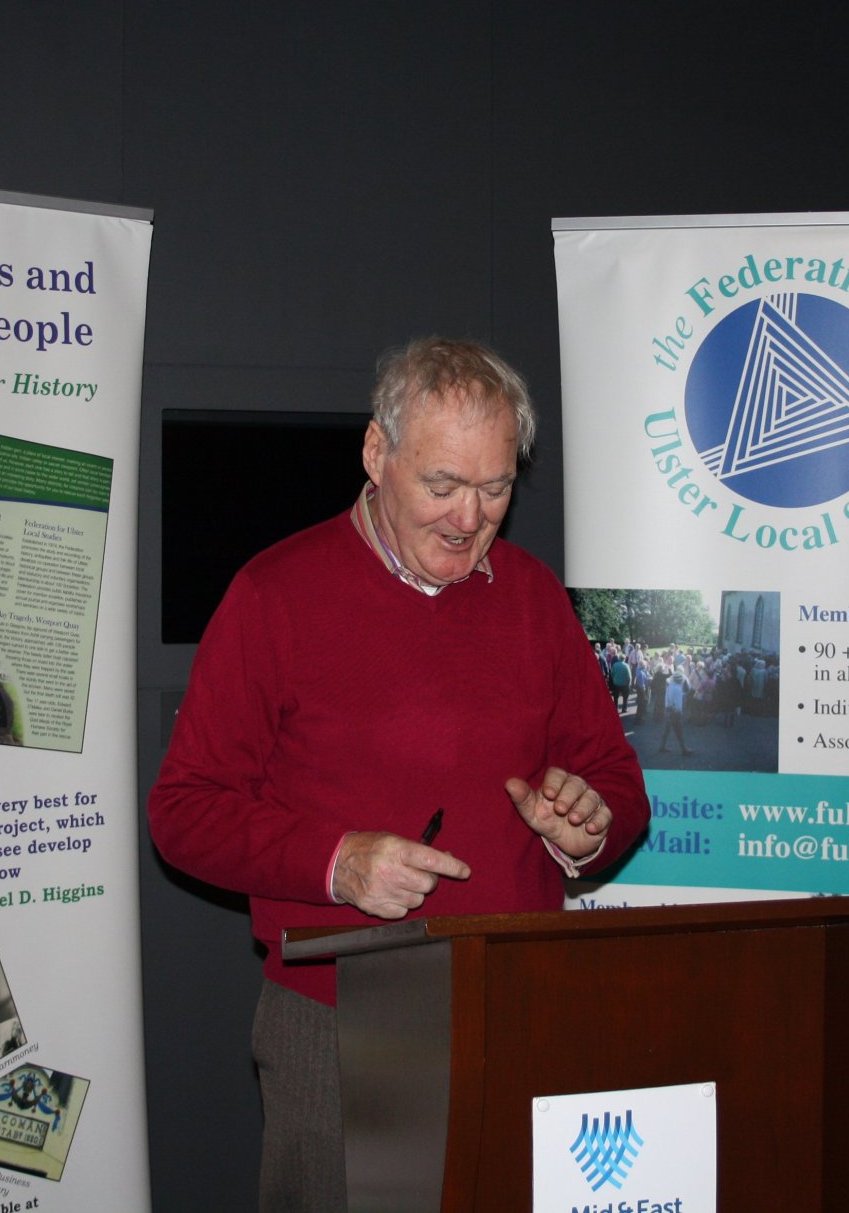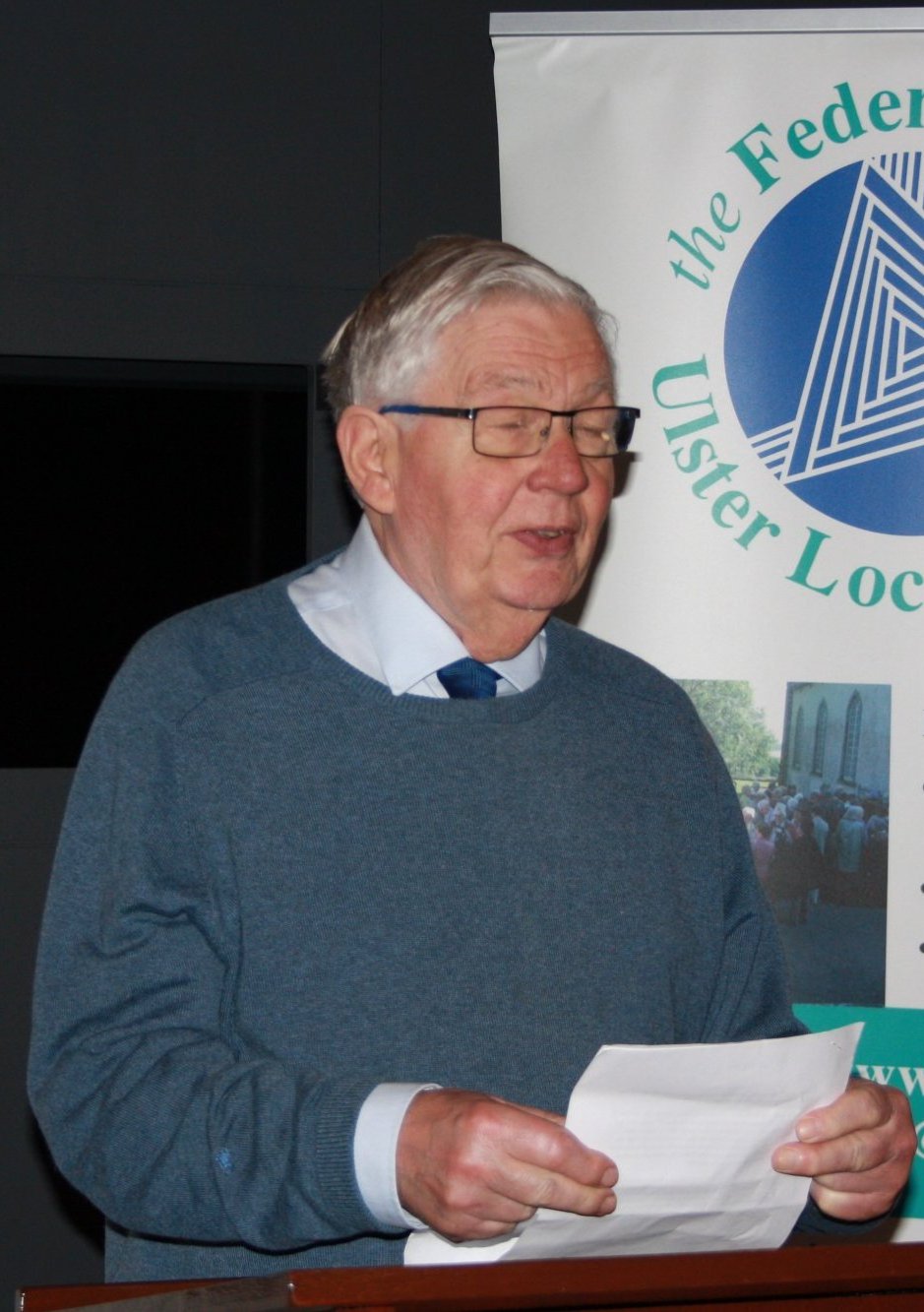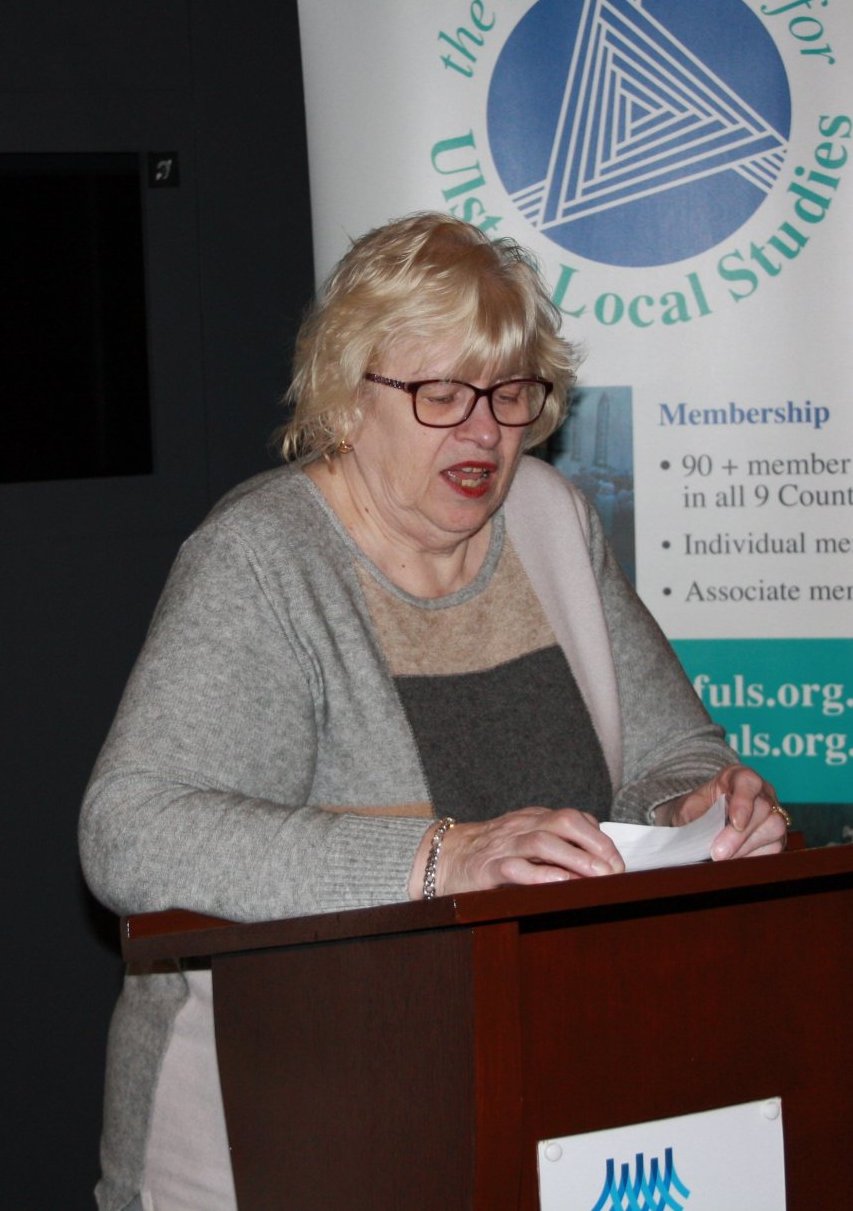Launch of Hidden Gems & Forgotten People Exhibition in
Carrickfergus Museum on
10 November 2018
The Exhibition was the eighth staged since September 2016. Thanks Shirin Murphy of the Museum for her help in making it happen.
 |
 Shirin Murphy, Carrickfergus Museum, welcomed the speakers and guests to the Exhibition. The Museum was happy to host it and it would remain until 8 December. She called on Alderman McKeen to launch the event
Shirin Murphy, Carrickfergus Museum, welcomed the speakers and guests to the Exhibition. The Museum was happy to host it and it would remain until 8 December. She called on Alderman McKeen to launch the event
 Alderman Gregg McKeen, Mid & East Antrim Borough Council, was pleased to launch the Exhibition, a joint effort of the Federation for Ulster Local Studies and the Federation of Local History Societies in the Republic of Ireland. He congratulated all those involved and referred to the comprehensive website that celebrated the lesser known places and the largely forgotten people who had contributed so much to their communities in the past. From its launch in Dublin in October 2015 it had been staged in many places and now, in cooperation with the Carrickfergus and District Historical Society, it was now here in Carrickfergus Museum. It showcased locations and people in the local area as well as others from further afield. He wished the Federations well in their endeavours.
Alderman Gregg McKeen, Mid & East Antrim Borough Council, was pleased to launch the Exhibition, a joint effort of the Federation for Ulster Local Studies and the Federation of Local History Societies in the Republic of Ireland. He congratulated all those involved and referred to the comprehensive website that celebrated the lesser known places and the largely forgotten people who had contributed so much to their communities in the past. From its launch in Dublin in October 2015 it had been staged in many places and now, in cooperation with the Carrickfergus and District Historical Society, it was now here in Carrickfergus Museum. It showcased locations and people in the local area as well as others from further afield. He wished the Federations well in their endeavours.
 Johnny Dooher, Chair of the Federation for Ulster Local Studies, said that the exhibition programme had been going now for three years. The main focus of the Federations has been to encourage local societies to identify such people and places in their own localities. The aim was to bring people together looking at local stories and memories of particular people who deserved to be better remembered in a permanent form. In relation to places, much had already been destroyed and this project might help to identify those that deserved to be recorded and preserved. It was an on-going project with the aim of generating more and more participation. A lot of work was being done by many people in many places and he wished to mention the work done by John Hulme in personally promoting the project and searching out people and places for the website, sometimes at some physical risk to himself, climbing over walls and gates. Johnny thanked those who had contributed. This exhibition may be the end of the current phase of the project and the Federations may need to take stock of how best to carry the project forward.
Johnny Dooher, Chair of the Federation for Ulster Local Studies, said that the exhibition programme had been going now for three years. The main focus of the Federations has been to encourage local societies to identify such people and places in their own localities. The aim was to bring people together looking at local stories and memories of particular people who deserved to be better remembered in a permanent form. In relation to places, much had already been destroyed and this project might help to identify those that deserved to be recorded and preserved. It was an on-going project with the aim of generating more and more participation. A lot of work was being done by many people in many places and he wished to mention the work done by John Hulme in personally promoting the project and searching out people and places for the website, sometimes at some physical risk to himself, climbing over walls and gates. Johnny thanked those who had contributed. This exhibition may be the end of the current phase of the project and the Federations may need to take stock of how best to carry the project forward.
 John Hulme, Carrickfergus & District Historical Society, said that the first time he heard of the project, at a Joint Meeting with the Federation of Local History Societies, he had been smitten and it had since become a great privilege and one of the joys of his life to be involved in it. In Carrickfergus, as elsewhere, there were amazing numbers of ruined buildings and structures and forgotten people. He would mention only a few of them.
John Hulme, Carrickfergus & District Historical Society, said that the first time he heard of the project, at a Joint Meeting with the Federation of Local History Societies, he had been smitten and it had since become a great privilege and one of the joys of his life to be involved in it. In Carrickfergus, as elsewhere, there were amazing numbers of ruined buildings and structures and forgotten people. He would mention only a few of them.
- Sean Lester, whose nephew was a member of the Carrickfergus Society, had been a journalist who became involved with the Irish Government and had been appointed to the League of Nations. Appointed as the League’s High Commissioner to the Free City of Danzig he resisted the German Nazi Government’s attempted take-over of the territory. He was later appointed as Secretary General and stayed in that position until the end of the war. Sean’s family were grocers and he was still trying to identify where building might be.
- Ardclinnis Church had been an ivy-covered heap of stones when he first came across it. It had been founded by St Mac Nissi, a near contemporary of St Patrick. A Bishop’s Crozier had been found that ended up in the National Museum of Ireland where it resided still. He had been priveleged to be able to hld the Crosier (with white gloves only).
- William Cameron whose nephew was a member of the Carrickfergus Society, had studied in Inst and later in QUB. He identified a set of hitherto unrecognised ultra-violet `bands’ of the gas carbon monoxide (CO). The `bands’ became known as the Cameron Bands, now used in space research.
- Bishop’s Palace, Kilroot. John recalled trying to access the site by climbing a gate which became unstable and started to sway. He had a choice of falling into a patch of nettles or a stony lane – he chose the nettles but managed to avoid getting stung.
 Helen Rankin, Carrickfergus & District Historical Society, said that we were meeting in a building that was on a multi-occupied site dating back to the twelfth century – a Franciscan Friary, that was the beginning of the town itself. She noted that all the artefacts that had been here when she left 10 years ago were still on display. The Carrickfergus Society was founded in November 1974, in the courtroom in the main town hall building. They still meet in the council offices. She had only been living in Carrickfergus since 1956 so was not yet ‘qualified’ as a resident. She was privileged to live in such a historic place. There was so much to see, so much to tell people. She came to work for the Council in 1974 and spent the next 30 years in historical research. At that time there was not much interest in local history but that was now beginning to change. The Society had built a new partnership with the Council and the Museum. Many new residents knew nothing about its rich history so there was much to do.
Helen Rankin, Carrickfergus & District Historical Society, said that we were meeting in a building that was on a multi-occupied site dating back to the twelfth century – a Franciscan Friary, that was the beginning of the town itself. She noted that all the artefacts that had been here when she left 10 years ago were still on display. The Carrickfergus Society was founded in November 1974, in the courtroom in the main town hall building. They still meet in the council offices. She had only been living in Carrickfergus since 1956 so was not yet ‘qualified’ as a resident. She was privileged to live in such a historic place. There was so much to see, so much to tell people. She came to work for the Council in 1974 and spent the next 30 years in historical research. At that time there was not much interest in local history but that was now beginning to change. The Society had built a new partnership with the Council and the Museum. Many new residents knew nothing about its rich history so there was much to do.
Helen mentioned John Hulme as a driving force for the project, using the Society’s bulletin to promote interest.
Finally, Shirin thanked everyone for their participation and the event came to a close.
 |



